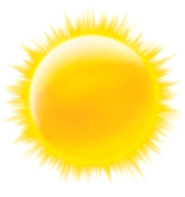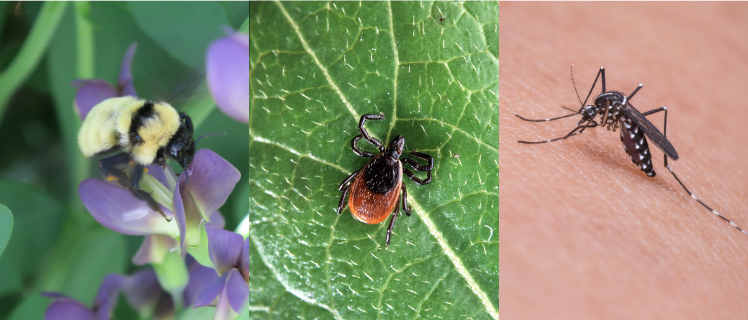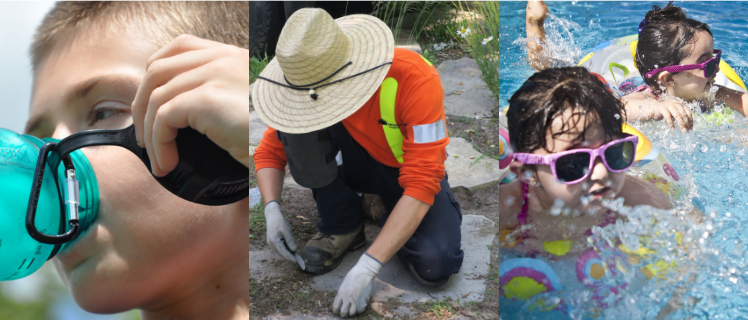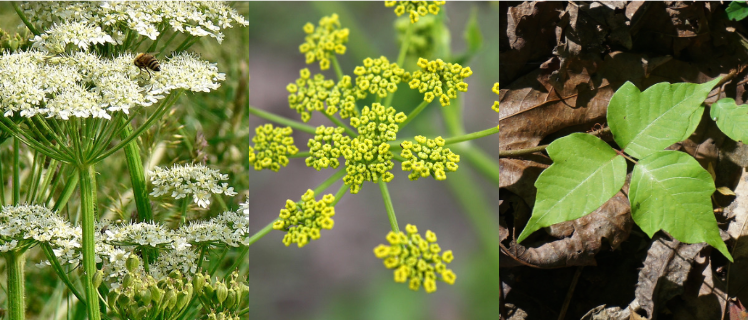Summer safety tips for you and your family

Ticks and other insects
This information is brought to you by Health Canada and Infrastructure Health and Safety Association (IHSA).

Can you identify a blacklegged tick?
Prevention tips!
- Use bug spray with DEET or picaridin (always follow directions and do not mix multiple sprays).
- Wear closed-toe shoes, long sleeves and pants.
- Tuck your shirt into your pants, and your pants into your socks.
- Walk on paths.
- Do a daily full-body tick check on yourself, your children, your pets and your gear.
- Shower or bathe within two hours of being outdoors.
- Put your clothes in a dryer on high heat for at least 10 minutes.
What should you do if you're bitten?
Use clean tweezers to immediately remove the attached ticks:
- Grasp the tick's head as close to your skin as possible.
- Slowly pull it straight out.
- If parts of the tick's mouth break off and remain in your skin, remove them with the tweezers.
- If you can't remove the mouthparts, leave them alone, and let your skin heal.
- Contact your health care provider if you're not feeling well or if you are concerned after being bitten by a tick.
- Keep the tick in a closed container and bring it with you if you go see your health care provider.
Early detection is key: the identification of Lyme disease in its early stages is very important. In most cases, if caught early, Lyme disease can be treated effectively with antibiotics.
What are the symptoms?
- Rash (sometimes shaped like a bull's eye)
- Fever
- Chills
- Headache
- Fatigue
- Aching muscles and joints
- Swollen lymph nodes
More severe symptoms (experienced weeks to months after a tick bite, if untreated) could include but are not limited to:
- Severe headaches
- New skin rashes
- Facial paralysis (such as Bell's palsy)
- Irregular heart beat
- Joint pain
- Nervous system disorders (such as dizziness, mental confusion or inability to think clearly, and memory loss, nerve pain, numbness or tingling in the hands or feet)
Mosquitos
Stinging Insects
 Lyme disease from Health Canada.
Lyme disease from Health Canada.Giant Hogweed and Wild Parsnip
Giant Hogweed and Wild Parsnip are invasive species that are increasingly common in eastern Ontario and disturbing them can result in significant health effects. Toxins in the plant's sap are photosensitive and can cause skin to react severely when exposed to sunlight and sap in the eyes can cause temporary blindness. If you see this plant or suspect you have seen it do not touch it.
How to identify Giant Hogweed
Giant hogweed may be found growing along roadsides, ditches and streams or in old fields and open woodlands.
Can reach a height of 2.5-5 metres
Large white, umbrella shaped flower clusters 30-90 cm across
Prominent purple blotches and coarse bristly hairs on the stem
How to identify Wild Parsnip
Wild Parsnip is commonly seen along the roadside and in open fields.
- Grows to 1-2.5 metres
- Yellowish-green flower clusters 10-20 cm across
- Smooth green stem with few hairs
Poison Ivy
Poison ivy is commonly found in the area. It is found in patches growing low to the ground or as a climbing vine. Sap from any part of the plant can cause a severe, itchy and blistering rash. The severity of the rash depends on the person's sensitivity and the amount of sap they are exposed to. If poison ivy is burned and the smoke is inhaled, or if the plant is accidentally eaten, the rash can occur internally causing extreme pain, breathing problems and organ damage.
Pets will not get a rash but can transfer the sap to humans from their fur.
How to identify poison ivy:
- Poison ivy is commonly found along trails, woods and roadsides.
- Three pointed leaflets – the middle leaflet has a longer stalk than the other two.
- Edges can be smooth or toothed.
- Leaves vary in size from 8-55 mm in length.
- Leaves are reddish in the spring, green in the summer and various shades of yellow, orange and red in the fall.
Sun safety basics
This information is brought to you by Health Canada.

It is important to protect against UV rays all year round, not just in the summer.
- Reflections off snow, water, sand and concrete can increase the effect of UV rays. You need to protect yourself on cloudy days, when you're swimming, and even while skiing.
- Children learn best by example. Model sun-protective behaviour yourself.
- In extreme heat, some medications may increase your health risk and/or make your skin more sensitive to UV rays. If you are taking medication, ask your health care provider if it increases your risk, and follow their recommendations.
- Tanning equipment will damage your skin and should be avoided.
- Sunless tanning products like bronzers are an alternative to tanning and come in different forms (sprays, lotions, towelettes). But while these products may give your skin a golden colour, they do not offer any UV protection. You still need to practice sun safety when using these products.
Sun safety tips
You can protect your family and still have fun under the sun.
-
Cover up. When the UV Index is three or higher, protect your skin as much as possible. Wear light-coloured, long-sleeved shirts, pants, and a wide-brimmed hat made from breathable fabric. When you buy sunglasses, make sure they provide protection against both UVA and UVB rays.
- Limit your time in the sun. Keep out of the sun and heat between 11 a.m. and 3 p.m. The UV index in Canada can be three or higher during those times. When your shadow is shorter than you, the sun is very strong. Look for places with lots of shade, like a park with big trees, partial roofs, awnings, umbrellas or gazebo tents. Always take an umbrella to the beach.
- Use the UV Index forecast. Tune in to local radio and TV stations or check online for the UV index forecast in your area. When the UV index is three or higher, wear protective clothing, sunglasses, and sunscreen, even when it's cloudy.
- Use sunscreen. Put sunscreen on when the UV index is three or higher. Use sunscreen labelled "broad spectrum" and "water resistant" with an SPF of at least 30.
- Drink plenty of cool liquids (especially water) before you feel thirsty. If sunny days are also hot and humid, stay cool and hydrated to avoid heat illness. Dehydration (not having enough fluids in your body) is dangerous, and thirst is not a good indicator of dehydration.
- Avoid using tanning equipment. There is no such thing as a 'healthy' tan. Using tanning equipment damages your skin and increases your risk of developing melanoma, the deadliest form of skin cancer.
